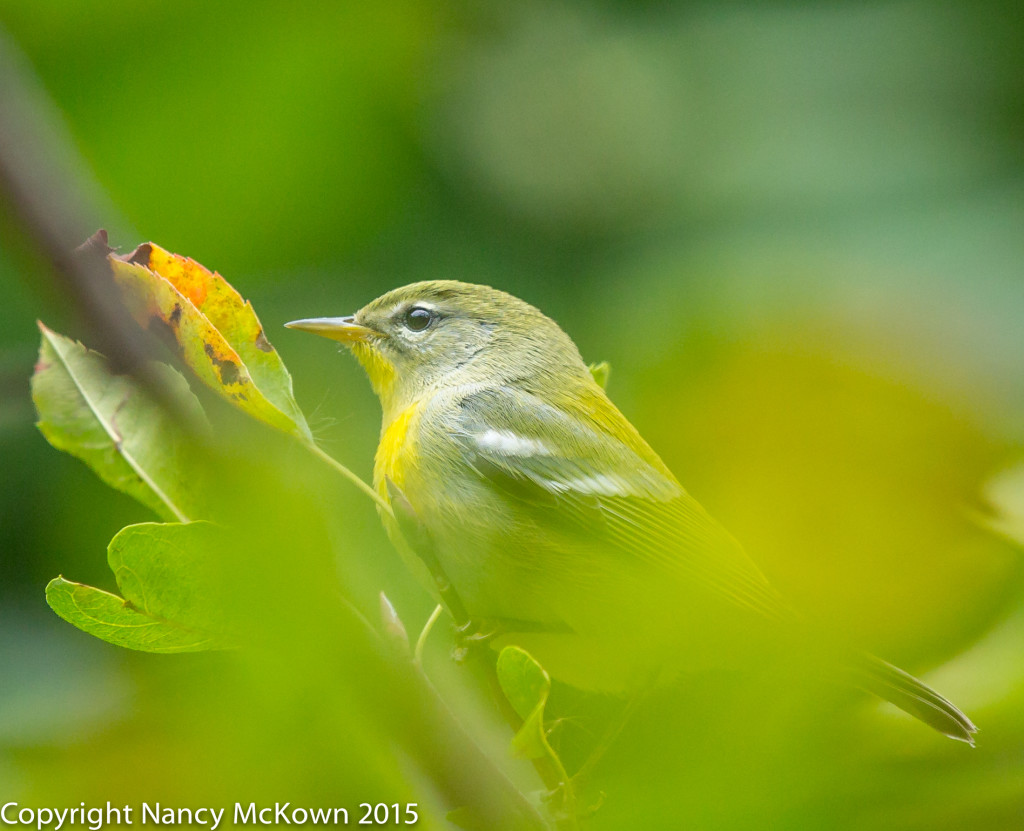Welcomed New Warblers
A couple of Northern Parula Warblers passed through our yard during fall migration — in mid September and again in early October. These little warblers have a preference for building their homes in Spanish Moss and are not known to nest in SW Michigan. Both Parula visits were quick, and happily, long enough for me to get off a couple shots to confirm ID at Whatbird.com.

ISO800; f/5.6; 1/500 Second
Auto Exposure Controls
Birds are constantly on the move, flittering and soaring in and out of the light. Most migrating warblers are around SW Michigan for a very short time, if they come at all. This unpredictability has led me to photograph birds mostly in Manual mode, where I feel I can respond the quickest. I rarely rely on my camera’s P, Tv or Av auto exposure controls.
Aperture Priority
I’ve wondered why so many bird photographers whose work I admire prefer to shoot exclusively in Av mode. In Av, the photographer sets the Aperture and the ISO, (unless Auto ISO is engaged) and the camera automatically sets the fastest shutter speed “allowed” for proper exposure, based on the cameras exposure calculations. (NOTE: The exposure settings the camera chooses appear in the viewfinder.)
A function that constantly patrols the light and sets exposure instantly is definitely advantageous, especially during those times when you can predict strong light and relatively unperturbed birds.
Functions to Enhance the Utility of Av Mode
User intervention tools are available on modern DSLR cameras that help make auto exposure settings more practical and precise in delivering consistent exposure. If the photographer is uneasy about the uneven light and the constantly changing automated readings while in Av mode, she can always tweak the auto exposure system by:
- Engaging Exposure Compensation (+/-). EC allows you to quickly adjust exposure by darkening or brightening the image. In Av mode, the camera will then respond by re-adjusting the shutter speed (or perhaps cranking up the ISO if Auto ISO is engaged) to get the shutter speed up to an acceptable level. (NOTE: See this link to learn more about EC. Remember, EC is NOT active in Manual mode).
- Pressing the “AE Lock-Hold” to temporarily put a hold on the Av. The camera’s AE Lock-Hold button tells the camera to retain whatever light readings auto exposure took immediately before pressing the AE lock and hold them until you press that button again. This is especially useful if you want to recompose a shot and not worry about the Av mode changing exposure because it is reading different light values when you recompose. AE Lock-Hold is only available in P, Tv or Av modes.
- Setting the Metering Mode. The camera’s auto exposure readings will be based, in part, on the metering mode you have set- Evaluative, Partial, Spot, or Center Weighted. Selecting an appropriate metering mode for the scene will go along way in helping auto exposure to correctly set exposure.
Concerns About Using Av Mode
- After using EC, I have to remember to set EC back to “0” so Av doesn’t keep compensating exposure 2 or 3 or 4 stops during my next set of shots.
- If I’m making exposure adjustments to auto exposure by using EC and AE Lock Hold, the convenience of Av mode is somewhat diminished. Setting Manual exposure on-the-fly is as convenient for me as fiddling with the various tools to over ride initial Av auto exposure readings.
- I have learned over the years that that my long lenses have very shallow depths of field…. to the point where I feel the need to close down the aperture on my 500 mm lens to f/8 or more. In low light, that tight aperture setting would give the camera’s auto exposure mechanism only a few options –options that may include setting a shutter speed that is just too slow for bird activity. If the shutter speed gets slow enough, even built-in image stabilization and a steady tripod would not prevent blurred images.
Whatever it Takes to Nail Exposure
Of course, whenever a challenge is posed when photographing birds, it doesn’t matter what exposure mode you’re in…. you’ve got to think fast to nail exposure. Clearly, some excellent nature photographers feel they have an edge when using the camera’s Av mode. That’s all that matters.

Spot Focusing helped me lock focus
on this warbler’s head
and blur the Leaves
in forefront and background.
ISO1000; f/5.6; 1/500 Second
Press this link to read more about Manual Mode.








